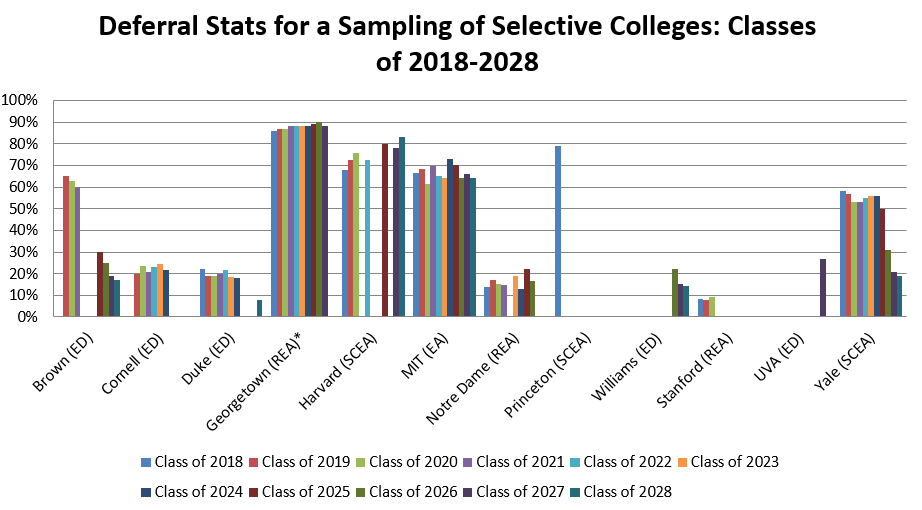 This is Part III of our series on Early Admissions for the Class of 2028. Colleges have varying policies on using high and low deferral rates, and recently some highly selective schools have switched to denying more and deferring fewer early applicants. This blog post takes a closer look at stats released for this year versus the past ten years. Take a look at Part I: Early Application Acceptance Rates for the Class of 2028 to understand overall trends in early applications and acceptance rates and Part II: Diversity to learn more about how colleges will pursue diversity after the Supreme Court ruling.
This is Part III of our series on Early Admissions for the Class of 2028. Colleges have varying policies on using high and low deferral rates, and recently some highly selective schools have switched to denying more and deferring fewer early applicants. This blog post takes a closer look at stats released for this year versus the past ten years. Take a look at Part I: Early Application Acceptance Rates for the Class of 2028 to understand overall trends in early applications and acceptance rates and Part II: Diversity to learn more about how colleges will pursue diversity after the Supreme Court ruling.
While in some ways the most uncertain status, being deferred – and not denied – means that you are in line with the college’s admissions profile, and that you are still in the running. Nevertheless, it is also important to realize that you are no longer dealing with higher early admissions acceptance rates, but rather with lower regular admission acceptance rates. Note that a deferral releases you from your early decision binding commitment to enroll if you are admitted.
Deferral rates are not as widely published as acceptance rates. However, available information shows that many schools defer more than half of their early applicant pool to the regular admissions round. This year, Harvard deferred 83% and denied about 8% of early applicants. MIT deferred 64% of early applicants and denied 25%. Georgetown and USC have a policy of deferring all students who are not accepted EA.
Notable exceptions include Duke, Middlebury, Northwestern, Notre Dame, and Stanford, who deny most applicants who are not accepted in the early round. For these schools, deferral is used to indicate that your application is very competitive, because if you are not in line with the school’s admissions standards you would be denied; therefore, you will be given serious consideration in the regular admissions process.
Yale has lowered its rate of deferral the past two years. For the Class of 2025 and classes prior, close to 50% of early applicants were deferred. In contrast, 31% were deferred for the Class of 2026, only 21% were deferred for the Class of 2027, and this year only 19% were deferred and 70% were denied. Brown has also decreased its deferral rate. For the Class of 2021, 60% of ED applicants were deferred; this year only 17% received deferral and 68% were denied.
Some schools, like the University of Michigan, use large numbers of deferrals to control yield and class size as they have continued to receive increasingly large early applicant pools. Some colleges defer especially strong candidates who may view the college as a “safe” school, wait to see if the student withdraws the application based on early acceptance by more selective colleges, and then may accept the student late-January through March.
The bar graph below shows the percent of early applications deferred for the classes of 2018-2028. Note how limited the publicly released information is. For example, Cornell and Duke stopped releasing deferral stats after the Class of 2024. Georgetown, MIT and Yale are among the few colleges that have consistently released deferral stats.
Percent of Early Apps Deferred for Recent Classes
*As of the fall 2018, Stanford stopped releasing admissions data
*Princeton has not released deferral stats since 2014
Our Tips
If you are deferred, there are several steps you can take in order to strengthen your application:
- If there is a 12th grade teacher who could add a different perspective to your application, consider asking them to submit an additional recommendation.
- Try to visit the college again and meet with professors in your areas of interest, if feasible.
- Write a follow-up note re-affirming your interest. Be genuine. If you would attend if accepted, say so. If not, state that you remain strongly interested in the college. If you have re-visited, discuss the specifics of your visit in your note. Summarize why the college is an excellent fit for you, and mention unique strengths and experiences you would contribute to campus. If appropriate, include updates of awards, special academic achievements or extracurricular projects that have occurred since you submitted your original application.
- Look at the college’s admissions website to learn specifically what follow-up information they would like to receive. Nearly all colleges will accept informational updates that help them assess your candidacy from a fresh perspective.
- Continue to engage in all your courses. Remember that colleges require your first semester senior year grades.
Follow the steps listed above to maximize your chances at the Regular Decision colleges on your list. This will give you the best range of options down the road. By the time you need to decide which college to attend on May 1st, your preferences may well have shifted.
Deciding whether and where to apply early can be daunting, especially now. But whatever your question, Collegiate Gateway is happy to help you decipher your options and understand the changing landscape of early admissions.

